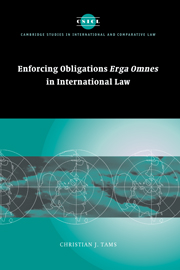Book contents
- Frontmatter
- Contents
- Foreword
- Preface
- Notes on citation
- Table of cases
- List of abbreviations
- Introduction
- Part I Background to the erga omnes concept
- Part II Legal issues raised by the erga omnes concept
- 3 Distinguishing types of erga omnes effects
- 4 Identifying obligations erga omnes
- 5 Standing to institute ICJ proceedings
- 6 Standing to take countermeasures
- 7 Erga omnes enforcement rights and competing enforcement mechanisms
- Conclusion
- Bibliography
- Index
- Cambridge Studies in International and Comparative Law
5 - Standing to institute ICJ proceedings
Published online by Cambridge University Press: 24 July 2009
- Frontmatter
- Contents
- Foreword
- Preface
- Notes on citation
- Table of cases
- List of abbreviations
- Introduction
- Part I Background to the erga omnes concept
- Part II Legal issues raised by the erga omnes concept
- 3 Distinguishing types of erga omnes effects
- 4 Identifying obligations erga omnes
- 5 Standing to institute ICJ proceedings
- 6 Standing to take countermeasures
- 7 Erga omnes enforcement rights and competing enforcement mechanisms
- Conclusion
- Bibliography
- Index
- Cambridge Studies in International and Comparative Law
Summary
Identifying obligations erga omnes is only one of the problems to which the Court's jurisprudence gives rise. As important is the question how States can respond to erga omnes breaches – often described as ‘the acid test of the erga omnes concept’. Indeed, if violations of obligations erga omnes did not trigger any special rights of response, the concept, at least for the purposes of law enforcement, would be of rhetorical value only. For the reasons given in the Introduction, only two means of enforcement are addressed in the present study: ICJ proceedings and countermeasures. It is convenient to begin by discussing the former of these, as it has historically provided the starting-point for the debate about erga omnes effects in the field of standing.
Since 1970, it has been disputed whether all States should be entitled to bring ICJ proceedings in response to breaches of obligations erga omnes. The different points of view are defined relatively clearly. According to most commentators, the question hardly needs to be addressed; the Court is said to have conclusively settled it in Barcelona Traction, when recognising the legal interest of all States in seeing obligations erga omnes observed. Byers, to take but one example, laconically states: ‘Generality of standing … is the essence of erga omnes rules.’ Following this interpretation (which will be referred to as the broad approach), obligations erga omnes are another category of obligations allowing for a general right to respond against breaches.
- Type
- Chapter
- Information
- Enforcing Obligations Erga Omnes in International Law , pp. 158 - 197Publisher: Cambridge University PressPrint publication year: 2005
- 3
- Cited by

